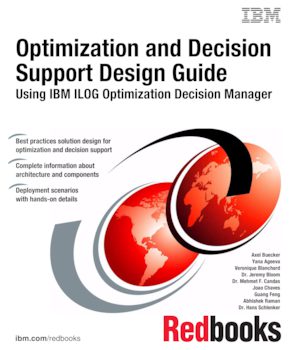About cookies on this site Our websites require some cookies to function properly (required). In addition, other cookies may be used with your consent to analyze site usage, improve the user experience and for advertising. For more information, please review your options. By visiting our website, you agree to our processing of information as described in IBM’sprivacy statement. To provide a smooth navigation, your cookie preferences will be shared across the IBM web domains listed here.

Published on 10 October 2012
Read in Google Books Order hardcopy
Share this page:
ISBN-10: 0738437360
ISBN-13: 9780738437361
IBM Form #: SG24-8017-00
Authors: Axel Buecker, Yana Ageeva, Veronique Blanchard, Dr. Jeremy Bloom, Dr. Mehmet F. Candas, Joao Chaves, Guang Feng, Abhishek Raman and Dr. Hans Schlenker
Abstract
Today many organizations face challenges when developing a realistic plan or schedule that provides the best possible balance between customer service and revenue goals. Optimization technology has long been used to find the best solutions to complex planning and scheduling problems. A decision-support environment that enables the flexible exploration of all the trade-offs and sensitivities needs to provide the following capabilities:
- Flexibility to develop and compare realistic planning and scheduling scenarios
- Quality sensitivity analysis and explanations
- Collaborative planning and scenario sharing
- Decision recommendations
This IBM® Redbooks® publication introduces you to the IBM ILOG® Optimization Decision Manager (ODM) Enterprise. This decision-support application provides the capabilities you need to take full advantage of optimization technology. Applications built with IBM ILOG ODM Enterprise can help users create, compare, and understand planning or scheduling scenarios. They can also adjust any of the model inputs or goals, and fully understanding the binding constraints, trade-offs, sensitivities, and business options.
This book enables business analysts, architects, and administrators to design and use their own operational decision management solution.
Table of Contents
Part 1. Business concepts, architecture, and design
Chapter 1. Context for optimization and analytic decision support
Chapter 2. Introducing the ODM Enterprise solution
Chapter 3. ODM Enterprise architecture
Chapter 4. Transforming business requirements into an ODM Enterprise application
Chapter 5. Solution design and management
Part 2. Customer use cases
Chapter 6. Case study: An insurance company
Chapter 7. Case study: A manufacturing company
Appendix A. IBM solution landscape for analytics, optimization, and decision support
Appendix B. Troubleshooting
Appendix C. Additional material